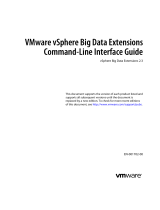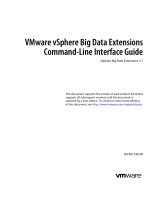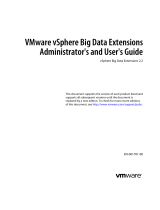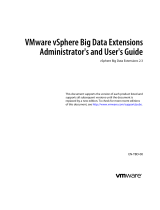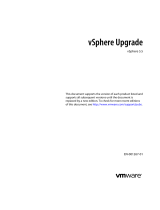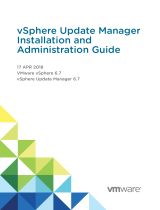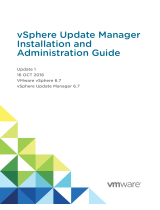Page is loading ...

VMware vSphere Big Data Extensions
Command-Line Interface Guide
vSphere Big Data Extensions 2.2
This document supports the version of each product listed and
supports all subsequent versions until the document is
replaced by a new edition. To check for more recent editions
of this document, see http://www.vmware.com/support/pubs.
EN-001702-00

VMware vSphere Big Data Extensions Command-Line Interface Guide
2 VMware, Inc.
You can find the most up-to-date technical documentation on the VMware Web site at:
http://www.vmware.com/support/
The VMware Web site also provides the latest product updates.
If you have comments about this documentation, submit your feedback to:
Copyright
©
2013 – 2015 VMware, Inc. All rights reserved. Copyright and trademark information.
This work is licensed under a Creative Commons Attribution-NoDerivs 3.0 United States License
(http://creativecommons.org/licenses/by-nd/3.0/us/legalcode).
VMware, Inc.
3401 Hillview Ave.
Palo Alto, CA 94304
www.vmware.com

Contents
About This Book 7
1
Using the Serengeti Remote Command-Line Interface Client 9
Access the Serengeti CLI By Using the Remote CLI Client 9
Log in to Hadoop Nodes with the Serengeti Command-Line Interface Client 10
2
Managing Application Managers 13
3
About Application Managers 15
4
Add an Application Manager by Using the Serengeti Command-Line
Interface 17
5
View List of Application Managers by using the Serengeti Command-Line
Interface 19
6
Modify an Application Manager by Using the Serengeti Command-Line
Interface 21
7
View Supported Distributions for All Application Managers by Using the
Serengeti Command-Line Interface 23
8
View Configurations or Roles for Application Manager and Distribution by
Using the Serengeti Command-Line Interface 25
9
Delete an Application Manager by Using the Serengeti Command-Line
Interface 27
10
Managing the Big Data Extensions Environment by Using the Serengeti
Command-Line Interface 29
About Application Managers 29
Add a Resource Pool with the Serengeti Command-Line Interface 32
Remove a Resource Pool with the Serengeti Command-Line Interface 33
Add a Datastore with the Serengeti Command-Line Interface 33
Remove a Datastore with the Serengeti Command-Line Interface 33
Add a Network with the Serengeti Command-Line Interface 34
Remove a Network with the Serengeti Command-Line Interface 34
Reconfigure a Static IP Network with the Serengeti Command-Line Interface 35
Reconfigure the DNS Type and Generate a Hostname with the Serengeti Command-Line Interface 35
Increase Cloning Performance and Resource Usage of Virtual Machines 36
VMware, Inc.
3

11
Managing Users and User Accounts 39
Create an LDAP Service Configuration File Using the Serengeti Command-Line Interface 39
Activate Centralized User Management Using the Serengeti Command-Line Interface 41
Create a Cluster With LDAP User Authentication Using the Serengeti Command-Line Interface 41
Change User Management Modes Using the Serengeti Command-Line Interface 42
Modify LDAP Configuration Using the Serengeti Command-Line Interface 43
12
Creating Hadoop and HBase Clusters 45
About Hadoop and HBase Cluster Deployment Types 47
Default Hadoop Cluster Configuration for Serengeti 47
Default HBase Cluster Configuration for Serengeti 48
About Cluster Topology 48
About HBase Clusters 51
About MapReduce Clusters 58
About Data Compute Clusters 61
About Customized Clusters 71
13
Managing Hadoop and HBase Clusters 79
Stop and Start a Cluster with the Serengeti Command-Line Interface 79
Scale Out a Cluster with the Serengeti Command-Line Interface 80
Scale CPU and RAM with the Serengeti Command-Line Interface 80
Reconfigure a Cluster with the Serengeti Command-Line Interface 81
About Resource Usage and Elastic Scaling 83
Delete a Cluster by Using the Serengeti Command-Line Interface 88
About vSphere High Availability and vSphere Fault Tolerance 88
Reconfigure a Node Group with the Serengeti Command-Line Interface 88
Recover from Disk Failure with the Serengeti Command-Line Interface Client 89
Enter Maintenance Mode to Perform Backup and Restore with the Serengeti Command-Line
Interface Client 89
14
Monitoring the Big Data Extensions Environment 91
View List of Application Managers by using the Serengeti Command-Line Interface 91
View Available Hadoop Distributions with the Serengeti Command-Line Interface 92
View Supported Distributions for All Application Managers by Using the Serengeti Command-
Line Interface 92
View Configurations or Roles for Application Manager and Distribution by Using the Serengeti
Command-Line Interface 92
View Provisioned Clusters with the Serengeti Command-Line Interface 93
View Datastores with the Serengeti Command-Line Interface 93
View Networks with the Serengeti Command-Line Interface 93
View Resource Pools with the Serengeti Command-Line Interface 94
15
Cluster Specification Reference 95
Cluster Specification File Requirements 95
Cluster Definition Requirements 95
Annotated Cluster Specification File 96
Cluster Specification Attribute Definitions 99
VMware vSphere Big Data Extensions Command-Line Interface Guide
4 VMware, Inc.

White Listed and Black Listed Hadoop Attributes 101
Convert Hadoop XML Files to Serengeti JSON Files 103
16
Serengeti CLI Command Reference 105
appmanager Commands 105
cluster Commands 107
connect Command 113
datastore Commands 114
disconnect Command 114
distro list Command 115
mgmtvmcfg Commands 115
network Commands 116
resourcepool Commands 118
topology Commands 118
usermgmt Commands 119
Index 121
Contents
VMware, Inc. 5

VMware vSphere Big Data Extensions Command-Line Interface Guide
6 VMware, Inc.

About This Book
VMware vSphere Big Data Extensions Command-Line Interface Guide describes how to use the Serengeti
Command-Line Interface (CLI) to manage the vSphere resources that you use to create Hadoop and HBase
clusters, and how to create, manage, and monitor Hadoop and HBase clusters with the VMware Serengeti™
CLI.
VMware vSphere Big Data Extensions Command-Line Interface Guide also describes how to perform Hadoop and
HBase operations with the Serengeti CLI, and provides cluster specification and Serengeti CLI command
references.
Intended Audience
This guide is for system administrators and developers who want to use Serengeti to deploy and manage
Hadoop clusters. To successfully work with Serengeti, you should be familiar with Hadoop and VMware
®
vSphere
®
.
VMware Technical Publications Glossary
VMware Technical Publications provides a glossary of terms that might be unfamiliar to you. For definitions
of terms as they are used in VMware technical documentation, go to
http://www.vmware.com/support/pubs.
VMware, Inc.
7

VMware vSphere Big Data Extensions Command-Line Interface Guide
8 VMware, Inc.

Using the Serengeti Remote
Command-Line Interface Client 1
The Serengeti Remote Command-Line Interface Client lets you access the Serengeti Management Server to
deploy, manage, and use Hadoop.
This chapter includes the following topics:
n
“Access the Serengeti CLI By Using the Remote CLI Client,” on page 9
n
“Log in to Hadoop Nodes with the Serengeti Command-Line Interface Client,” on page 10
Access the Serengeti CLI By Using the Remote CLI Client
You can access the Serengeti Command-Line Interface (CLI) to perform Serengeti administrative tasks with
the Serengeti Remote CLI Client.
Prerequisites
n
Use the VMware vSphere Web Client to log in to the VMware vCenter Server
®
on which you deployed
the Serengeti vApp.
n
Verify that the Serengeti vApp deployment was successful and that the Management Server is running.
n
Verify that you have the correct password to log in to Serengeti CLI. See the VMware vSphere Big Data
Extensions Administrator's and User's Guide.
The Serengeti CLI uses its vCenter Server credentials.
n
Verify that the Java Runtime Environment (JRE) is installed in your environment and that its location is
in your path environment variable.
Procedure
1 Download the Serengeti CLI package from the Serengeti Management Server.
Open a Web browser and navigate to the following URL: https://server_ip_address/cli/VMware-
Serengeti-CLI.zip
2 Download the ZIP file.
The filename is in the format VMware-Serengeti-cli-version_number-build_number.ZIP.
3 Unzip the download.
The download includes the following components.
n
The serengeti-cli-version_number JAR file, which includes the Serengeti Remote CLI Client.
n
The samples directory, which includes sample cluster configurations.
n
Libraries in the lib directory.
VMware, Inc.
9

4 Open a command shell, and change to the directory where you unzipped the package.
5 Change to the cli directory, and run the following command to enter the Serengeti CLI.
n
For any language other than French or German, run the following command.
java -jar serengeti-cli-version_number.jar
n
For French or German languages, which use code page 850 (CP 850) language encoding when
running the Serengeti CLI from a Windows command console, run the following command.
java -Dfile.encoding=cp850 -jar serengeti-cli-version_number.jar
6 Connect to the Serengeti service.
You must run the connect host command every time you begin a CLI session, and again after the 30
minute session timeout. If you do not run this command, you cannot run any other commands.
a Run the connect command.
connect --host xx.xx.xx.xx:8443
b At the prompt, type your user name, which might be different from your login credentials for the
Serengeti Management Server.
NOTE If you do not create a user name and password for the
Serengeti Command-Line Interface Client, you can use the default vCenter Server administrator
credentials. The Serengeti Command-Line Interface Client uses the vCenter Server login credentials
with read permissions on the Serengeti Management Server.
c At the prompt, type your password.
A command shell opens, and the Serengeti CLI prompt appears. You can use the help command to get help
with Serengeti commands and command syntax.
n
To display a list of available commands, type help.
n
To get help for a specific command, append the name of the command to the help command.
help cluster create
n
Press Tab to complete a command.
Log in to Hadoop Nodes with the Serengeti Command-Line Interface
Client
To perform troubleshooting or to run your management automation scripts, log in to Hadoop master,
worker, and client nodes with SSH from the Serengeti Management Server using SSH client tools such as
SSH, PDSH, ClusterSSH, and Mussh, which do not require password authentication.
To connect to Hadoop cluster nodes over SSH, you can use a user name and password authenticated login.
All deployed nodes are password-protected with either a random password or a user-specified password
that was assigned when the cluster was created.
Prerequisites
Use the vSphere Web Client to log in to vCenter Server, and verify that the Serengeti Management Server
virtual machine is running.
VMware vSphere Big Data Extensions Command-Line Interface Guide
10 VMware, Inc.

Procedure
1 Right-click the Serengeti Management Server virtual machine and select Open Console.
The password for the Serengeti Management Server appears.
NOTE If the password scrolls off the console screen, press Ctrl+D to return to the command prompt.
2 Use the vSphere Web Client to log in to the Hadoop node.
The password for the root user appears on the virtual machine console in the vSphere Web Client.
3 Change the password of the Hadoop node by running the set-password -u command.
sudo /opt/serengeti/sbin/set-password -u
Chapter 1 Using the Serengeti Remote Command-Line Interface Client
VMware, Inc. 11

VMware vSphere Big Data Extensions Command-Line Interface Guide
12 VMware, Inc.

Managing Application Managers 2
A key to managing your Hadoop clusters is understanding how to manage the different application
managers that you use in your Big Data Extensions environment.
VMware, Inc. 13

VMware vSphere Big Data Extensions Command-Line Interface Guide
14 VMware, Inc.

About Application Managers 3
You can use Cloudera Manager, Ambari, and the default application manager to provision and manage
clusters with VMware vSphere Big Data Extensions.
After you add a new Cloudera Manager or Ambari application manager to Big Data Extensions, you can
redirect your software management tasks, including monitoring and managing clusters, to that application
manager.
You can use an application manager to perform the following tasks:
n
List all available vendor instances, supported distributions, and configurations or roles for a specific
application manager and distribution.
n
Create clusters.
n
Monitor and manage services from the application manager console.
Check the documentation for your application manager for tool-specific requirements.
Restrictions
The following restrictions apply to Cloudera Manager and Ambari application managers:
n
To add an application manager with HTTPS, use the FQDN instead of the URL.
n
You cannot rename a cluster that was created with a Cloudera Manager or Ambari application
manager.
n
You cannot change services for a big data cluster from Big Data Extensions if the cluster was created
with Ambari or Cloudera Manager application manager.
n
To change services, configurations, or both, you must make the changes from the application manager
on the nodes.
If you install new services, Big Data Extensions starts and stops the new services together with old
services.
n
If you use an application manager to change services and big data cluster configurations, those changes
cannot be synced from Big Data Extensions. The nodes that you create with Big Data Extensions do not
contain the new services or configurations.
VMware, Inc.
15

VMware vSphere Big Data Extensions Command-Line Interface Guide
16 VMware, Inc.

Add an Application Manager by
Using the Serengeti Command-Line
Interface 4
To use either Cloudera Manager or Ambari application managers, you must add the application manager
and add server information to Big Data Extensions.
NOTE If you want to add a Cloudera Manager or Ambari application manager with HTTPS, use the FQDN
in place of the URL.
Procedure
1 Access the Serengeti CLI.
2 Run the appmanager add command.
appmanager add --name application_manager_name --type [ClouderaManager|Ambari]
--url http[s]://server:port
Application manager names can include only alphanumeric characters ([0-9, a-z, A-Z]) and the
following special characters; underscores, hyphens, and blank spaces.
You can use the optional description variable to include a description of the application manager
instance.
3 Enter your username and password at the prompt.
4 If you specified SSL, enter the file path of the SSL certificate at the prompt.
What to do next
To verify that the application manager was added successfully, run the appmanager list command.
VMware, Inc.
17

VMware vSphere Big Data Extensions Command-Line Interface Guide
18 VMware, Inc.

View List of Application Managers by
using the Serengeti Command-Line
Interface 5
You can use the appManager list command to list the application managers that are installed on the
Big Data Extensions environment.
Prerequisites
Verify that you are connected to an application manager.
Procedure
1 Access the Serengeti CLI.
2 Run the appmanager list command.
appmanager list
The command returns a list of all application managers that are installed on the Big Data Extensions
environment.
VMware, Inc.
19

VMware vSphere Big Data Extensions Command-Line Interface Guide
20 VMware, Inc.
/
